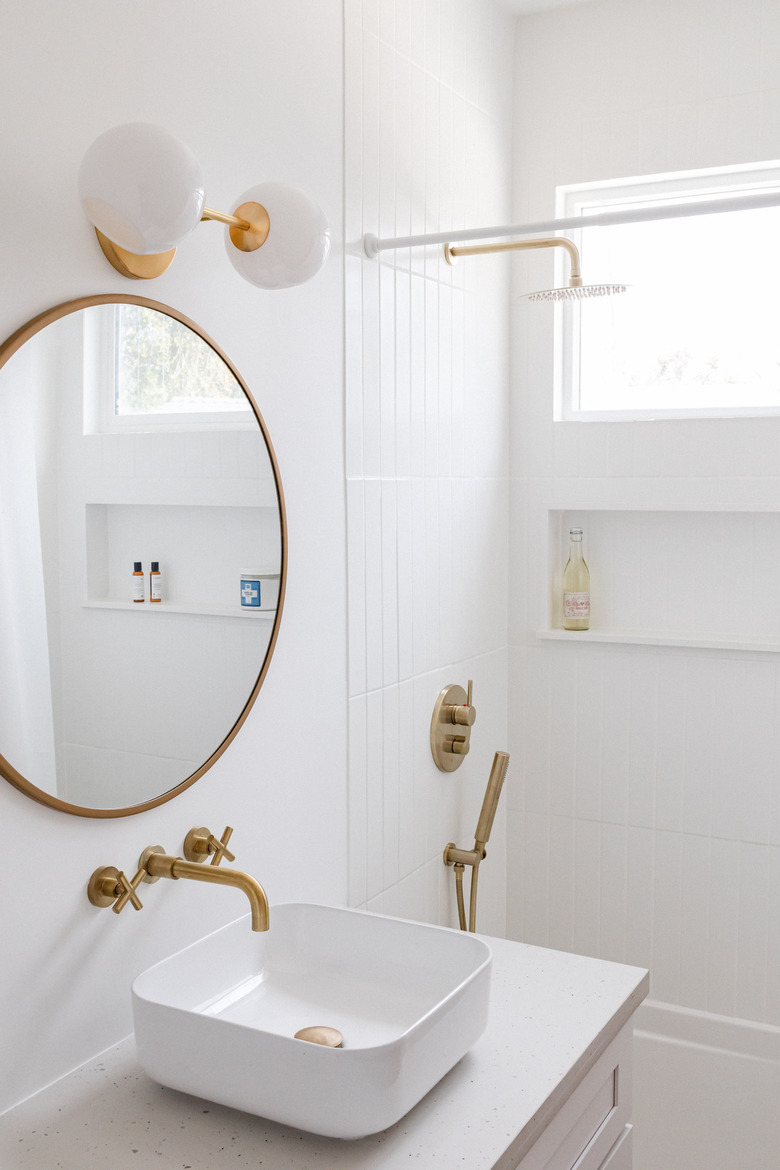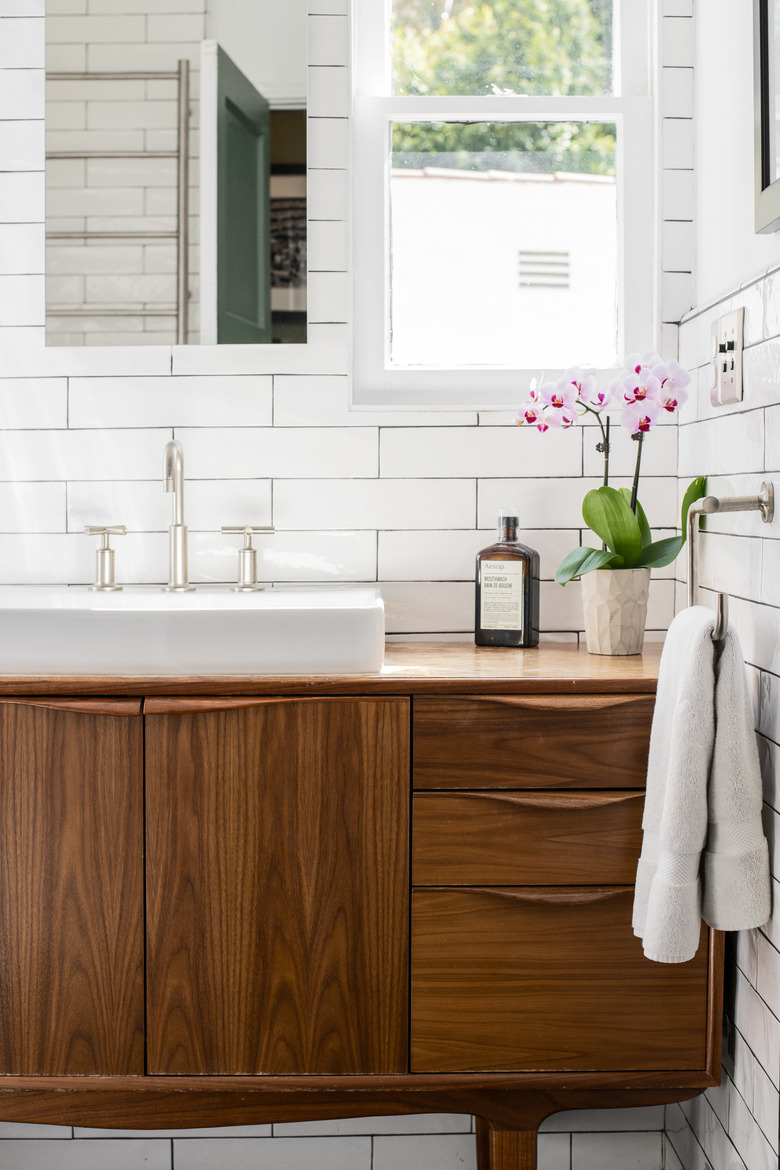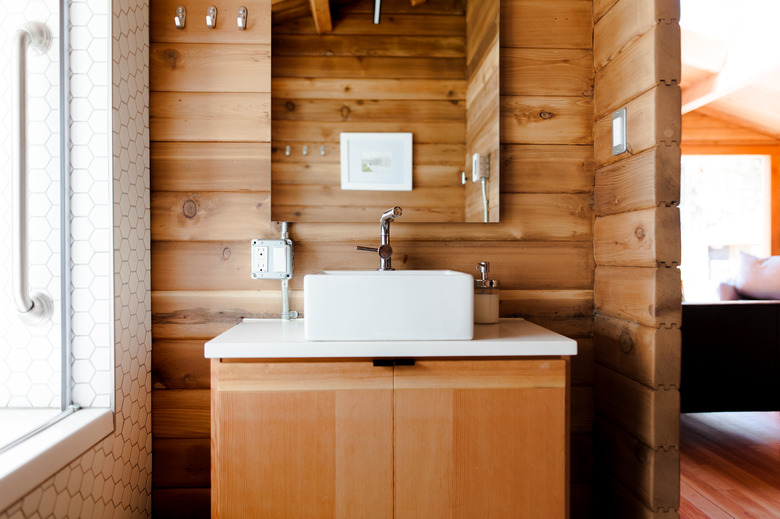Homeowner's Guide To Vessel Bathroom Sinks
The first time you saw a designer vessel sink, you may have thought that you had just walked into the boudoir of a 17th-century French aristocrat. Not all vessel bathroom sinks are designer pieces, but they all have one thing in common, which is that they either sit on top of the bathroom countertop or are partially recessed within it. This is in contrast to a drop-in sink, which is completely recessed, and an undermount sink, which is mounted below the countertop.
If you were to place sinks on a scale from beautiful to practical, vessel bathroom sinks would be closer to the beautiful end than other sinks, which puts them farther from the practical end. Some manufacturers, such as Kohler and Kraus, provide square and rectangular models that are more practical than purely decorative ones, but they still aren't as practical as drop-ins or undermounts. That's because they have an inherent weakness — they lack overflow holes, so they can potentially overfill and spill water onto the countertop and the floor.
Vessel Sink Styles and Materials
Vessel Sink Styles and Materials
Part of the appeal of a vessel sink is that it's a throwback to days when a sink was just a vessel that sat on the countertop. The vessel in the laundry room or kitchen didn't have to be pretty, so it was little more than a steel laundry tub or washbasin, but the one in the master bedroom or bar area had to be a conversation piece, so it was often made of copper, vitreous china, fireclay or some other luxury material.
Today's designer vessel bathroom sinks can be made from these same materials, but you'll also find ones made from stainless steel, glass or natural stone and even hewn from wood burl. More utilitarian models are made from porcelain, fireclay and cast iron, just like drop-in and undermount sinks.
If style is your priority, you'll probably prefer an oval or round vessel sink in a luxury material for an elegant look. If you're more interested in function, then you should choose from a wide selection of square or rectangular porcelain and ceramic vessel bathroom sinks. Manufacturers provide vessel sinks with a depth of 6 1/2 inches, which is the maximum allowable to make a sink ADA compliant, according to Patient Safety USA.
Vessel Bathroom Sink Pros and Cons
Vessel Bathroom Sink Pros and Cons
Not everyone is in favor of vessel sinks, and for Kingston Brass, the cons outweigh the pros. On the plus side, a vessel bathroom sink is:
- Stylish, which is the number one reason for its popularity. Nothing transforms a bathroom like a matte stone vessel sink accompanied by a waterfall faucet.
- Easy to install, which is a selling point for the DIYer looking to complete a bathroom remodel without hiring a plumber.
- Easy to replace when the sink becomes outdated or gets damaged.
- Space-saving depending on style, as round and oval vessel sinks that sit on the countertop leave all the counter space that would have been occupied by the rim if the sink was inset.
One of the main drawbacks of vessel bathroom sinks is the potential to overflow. Besides that, a few other problems have led to buyer's remorse for some homeowners:
- They are hard to clean, especially around the base. Add to this the fact that water tends to splash more frequently, especially when the sink is used in conjunction with a wall-mount faucet, and this necessitates more frequent cleaning.
- There is lack of stability at the point where the sink connects to the drain, which is often the only connection the sink has to the countertop.
- Fragility is an issue with some materials. Give a glass vessel sink or one made from vitreous china an inadvertent whack with a hairbrush or broom handle and you could be looking for a new sink.
- They have a high rim, which could be a problem for children or short adults.
Installation of Vessel Bathroom Sinks
Installation of Vessel Bathroom Sinks
When it comes to hooking up the drain, the procedure for a vessel sink is the same as it is for any other type, but if the sink sits directly on the countertop, it's much easier to install. Instead of making a cutout for the sink rim, all you need to do is drill a 1 1/2- to 2-inch hole for the drain, and the drain connection holds the sink to the countertop. This is a big advantage if the countertop is made of smooth stone or a similarly hard material, and it also works well with solid-surface materials, such as Corian and Silestone, as well as solid wood and laminates. You might want to think twice before installing a vessel sink on an uneven surface, such as ceramic tile, because it might be difficult to seal the gap between the bottom of the sink and the countertop.
Vessel sinks have no faucet holes, so the sink faucet has to go either on the countertop or on the wall. If you choose one that mounts on the countertop, be sure to measure how much space you have, especially if you're converting a vintage cabinet to a bathroom vanity. Keep in mind that you can always set the faucet off to the side if the cabinet isn't deep enough, and you can still hook up a pop-up drain stopper in this configuration if you prefer that to a grid strainer.
You need a high-arc faucet to clear the rim, and while the spout shouldn't be too high from the base of the sink or water will splash, it must be at least 1 inch above the rim to satisfy code. You can purchase a vessel faucet set from a manufacturer such as Kohler or Kraus that satisfies both requirements and comes with a brass or oil-rubbed bronze finish that completes the transformation of your modern bathroom. The same height considerations apply to a wall-mount faucet, and because a wall-mount has to be installed independently of the sink (and usually before it), it's important to carefully measure its height before you install it.
How to Maintain a Bathroom Vessel Sink
How to Maintain a Bathroom Vessel Sink
Unlike top-mount or undermount sinks, bathroom vessel sinks have two exposed sides, and both need cleaning. While the best cleaning method depends on the sink material, some methods work for most of them. For starters, wiping down the inside and outside of the sink after each use prevents grime from accumulating, and more importantly, it prevents mineral deposits from creating a haze that can disfigure a stylish glass or stone sink.
You can remove mineral haze from nonporous surfaces, such as glass, ceramic and stainless steel, using a paste made with vinegar and a powder that won't react with it, such as borax — not baking soda. Vinegar and other common cleaners can etch stone, though, so if your sink is natural stone, use a commercial cleaner recommended for that type of stone.
The most problematic area is the underside of the sink where it meets the countertop, and this is also an area where leaks can occur. When installing the sink, it's a good idea to seal this gap with clear silicone caulk, spreading the caulk around the top edge of the drain opening and inside it so it won't be visible. If water does seep through this opening, tighten the drain opening and apply more caulk from underneath to reinforce the seal.
References
- Patient Safety USA: Choosing A Wheelchair Accessible Bathroom Sink
- Kingston Brass: The Controversial Vessel Sink: Pros and Cons of an Ubiquitous Trend
- Cheviot: Vessel Sink Maintenance: A Guide to Proper Care and Cleaning
- Cheviot: Bathroom Vessel Sink Install Guide: Simple Tips for an Elegant Upgrade


